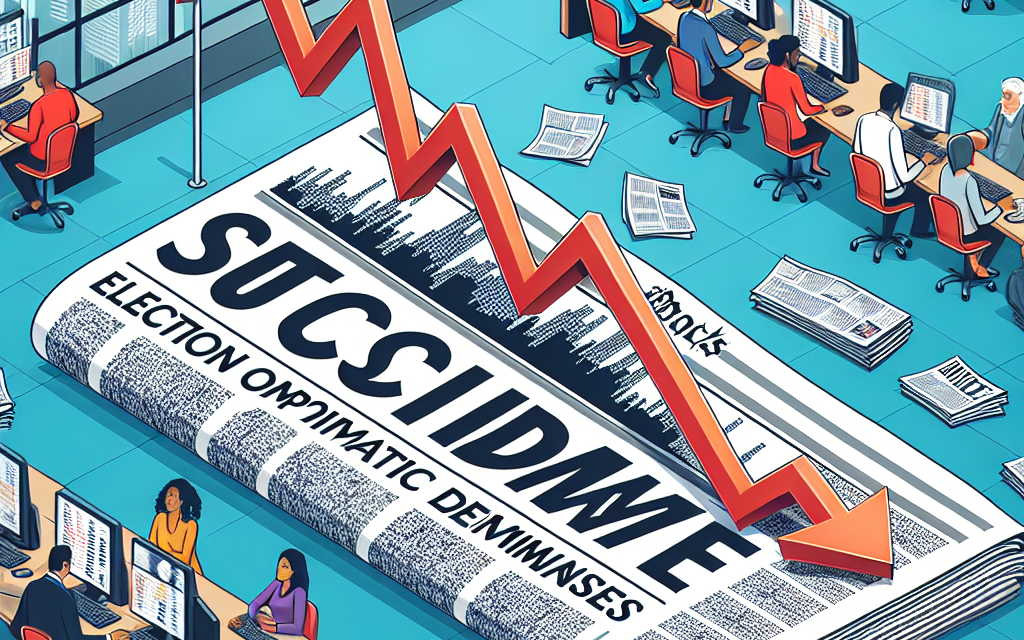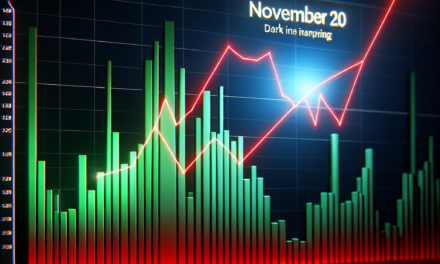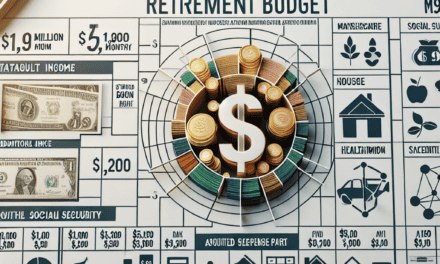“Markets Tumble: Election Hopes Fade, Stocks Stagger”
Introduction
In recent trading sessions, financial markets have experienced a notable downturn as initial optimism surrounding upcoming elections begins to wane. Investors, who had previously anticipated favorable outcomes that might bolster economic policies and market stability, are now reassessing their positions amid growing uncertainties. This shift in sentiment has led to a decline in stock prices across various sectors, reflecting broader concerns about potential political and economic implications. As market participants navigate this evolving landscape, the focus has turned to key indicators and developments that could influence future market trajectories.
Impact Of Political Uncertainty On Stock Markets
The stock markets have long been sensitive to political developments, and the recent decline in market performance underscores the profound impact of political uncertainty on investor sentiment. As election optimism diminishes, the volatility in the markets has become more pronounced, reflecting the intricate relationship between political events and economic stability. Investors, who initially anticipated a clear and decisive outcome in the upcoming elections, are now grappling with the potential for prolonged uncertainty, which has led to a noticeable decline in stock prices.
Political uncertainty often translates into economic unpredictability, as businesses and investors struggle to forecast future policy directions. This unpredictability can lead to a cautious approach in investment strategies, as stakeholders await clearer signals from the political arena. The current situation is no exception, with market participants closely monitoring election developments to gauge potential shifts in economic policies. The lack of clarity regarding future leadership and policy priorities has resulted in a risk-averse environment, prompting many investors to pull back from equities and seek refuge in safer assets.
Moreover, the impact of political uncertainty is not confined to domestic markets alone. Global markets are also feeling the ripple effects, as international investors reassess their exposure to U.S. equities. The interconnectedness of global financial systems means that political developments in one country can have far-reaching implications, influencing investor behavior worldwide. Consequently, the decline in U.S. stock markets has been mirrored in other major financial centers, further exacerbating the sense of instability.
In addition to the direct impact on stock prices, political uncertainty can also affect corporate decision-making. Companies may delay or scale back investment plans, mergers, and acquisitions until there is greater clarity on the political front. This hesitancy can stifle economic growth, as businesses adopt a wait-and-see approach, potentially leading to reduced job creation and slower economic expansion. The current environment of uncertainty is likely to weigh on corporate earnings, as firms navigate the challenges posed by an unpredictable political landscape.
Furthermore, the decline in market performance can have broader implications for consumer confidence. As stock prices fall, individuals may feel less wealthy, leading to reduced consumer spending, which is a critical driver of economic growth. The interplay between consumer confidence and market performance creates a feedback loop, where declining markets can dampen consumer sentiment, further impacting economic activity.
Despite these challenges, it is important to recognize that markets are inherently resilient and have historically rebounded from periods of political uncertainty. While the current situation may seem daunting, investors should remain focused on long-term fundamentals rather than short-term fluctuations. Diversification and a disciplined investment approach can help mitigate the risks associated with political uncertainty, allowing investors to navigate turbulent times with greater confidence.
In conclusion, the decline in stock markets amid diminishing election optimism highlights the significant impact of political uncertainty on financial markets. As investors and businesses grapple with the potential for prolonged ambiguity, the effects are being felt across domestic and global markets. However, by maintaining a long-term perspective and adopting prudent investment strategies, stakeholders can better manage the challenges posed by political uncertainty and position themselves for future opportunities.
Analyzing The Correlation Between Elections And Market Volatility
The intricate relationship between elections and market volatility has long been a subject of interest for economists and investors alike. As the political landscape shifts, so too does the financial market, often reacting with heightened sensitivity to the prospects of policy changes and economic reforms. This dynamic interplay is particularly evident during election periods, when uncertainty looms large and investor sentiment can swing dramatically. Recent market trends have underscored this phenomenon, as initial optimism surrounding upcoming elections has given way to a more cautious outlook, resulting in a notable decline in stock prices.
To understand the correlation between elections and market volatility, it is essential to consider the factors that drive investor behavior during these times. Elections inherently introduce a degree of uncertainty, as the potential for significant policy shifts can impact various sectors differently. Investors, therefore, tend to react to both the anticipated outcomes and the actual results of elections, adjusting their portfolios in response to perceived risks and opportunities. This behavior often leads to increased market volatility, as the collective actions of investors create fluctuations in stock prices.
Initially, markets may experience a surge of optimism as candidates propose policies that promise economic growth or stability. This optimism is often reflected in rising stock prices, as investors anticipate favorable conditions for businesses and industries. However, as the election date approaches and the political landscape becomes more complex, this initial optimism can wane. Factors such as contentious debates, shifting public opinion, and unexpected developments can introduce new uncertainties, prompting investors to reassess their positions.
The recent decline in stock prices serves as a case in point. As election optimism diminishes, investors are increasingly wary of the potential for policy changes that could disrupt economic stability. Concerns over regulatory shifts, tax reforms, and international trade agreements are just a few of the issues that can weigh heavily on investor sentiment. Moreover, the global nature of financial markets means that domestic elections can have far-reaching implications, influencing not only local markets but also international ones.
In addition to these factors, the role of media coverage and public perception cannot be overlooked. The way in which election-related news is reported can significantly impact investor confidence. Sensational headlines and speculative reporting can exacerbate market volatility, as investors react to perceived threats or opportunities. This underscores the importance of critical analysis and informed decision-making during election periods, as knee-jerk reactions can lead to suboptimal investment outcomes.
Furthermore, historical data provides valuable insights into the patterns of market behavior during elections. While each election is unique, past trends can offer guidance on how markets might respond to similar circumstances. For instance, it is not uncommon for markets to experience a period of heightened volatility in the months leading up to an election, followed by a stabilization phase once the results are known and the policy direction becomes clearer.
In conclusion, the correlation between elections and market volatility is a complex and multifaceted phenomenon. As recent trends have demonstrated, initial election optimism can quickly give way to caution as uncertainties mount. Investors must navigate this landscape with care, balancing the potential risks and rewards associated with political change. By understanding the factors that drive market behavior during elections, investors can better position themselves to weather the inevitable fluctuations and capitalize on emerging opportunities.
Investor Sentiment: How Elections Influence Market Trends
Investor sentiment plays a crucial role in shaping market trends, particularly during election periods when uncertainty and speculation are at their peak. As the election season unfolds, markets often experience heightened volatility, driven by the anticipation of potential policy changes and their subsequent impact on various sectors. Initially, optimism may buoy markets as investors speculate on favorable outcomes that could stimulate economic growth. However, as the election date approaches and the political landscape becomes more defined, this optimism can wane, leading to market declines.
The influence of elections on market trends is multifaceted, involving a complex interplay of economic policies, regulatory changes, and geopolitical considerations. Investors closely monitor candidates’ platforms, assessing how proposed policies might affect industries such as healthcare, energy, and technology. For instance, a candidate advocating for increased regulation in the tech sector might cause tech stocks to dip, while promises of tax cuts could boost investor confidence in consumer-driven sectors. Consequently, the market’s initial optimism is often tempered by the realization that not all proposed policies will be beneficial to every sector.
Moreover, the uncertainty surrounding election outcomes can exacerbate market volatility. Investors are inherently risk-averse, and the prospect of a significant shift in government policy can lead to cautious behavior. This caution is reflected in the form of reduced trading volumes and increased demand for safe-haven assets such as gold and government bonds. As a result, stock markets may experience a decline as investors seek to mitigate potential risks associated with political transitions.
In addition to domestic policies, elections can also influence international relations, further impacting market trends. Changes in trade policies, for example, can have far-reaching effects on global supply chains and international markets. Investors must consider how a new administration might alter existing trade agreements or impose tariffs, which could affect multinational corporations and, by extension, the broader market. This global perspective adds another layer of complexity to investor sentiment during election periods.
Furthermore, historical data suggests that markets tend to perform differently depending on which political party is perceived to have an advantage. Traditionally, markets have favored pro-business policies often associated with conservative parties, while liberal parties’ focus on social welfare and regulation can lead to mixed reactions. However, these trends are not absolute and can vary based on the specific economic context and the candidates’ unique platforms. Therefore, investors must remain vigilant and adaptable, recognizing that past performance is not always indicative of future results.
As election optimism diminishes, it is essential for investors to adopt a strategic approach, balancing short-term market reactions with long-term investment goals. Diversification remains a key strategy, allowing investors to spread risk across various asset classes and sectors. Additionally, maintaining a focus on fundamental analysis can help investors identify undervalued opportunities that may arise amid market fluctuations.
In conclusion, elections undeniably influence market trends through their impact on investor sentiment. While initial optimism may drive markets upward, the subsequent realization of potential policy changes and geopolitical shifts can lead to declines. By understanding the multifaceted nature of these influences, investors can better navigate the complexities of election periods, making informed decisions that align with their financial objectives. As the political landscape continues to evolve, staying informed and adaptable will be crucial for investors seeking to capitalize on opportunities while mitigating risks.
Historical Patterns: Market Behavior During Election Cycles

Throughout history, financial markets have exhibited distinct patterns of behavior during election cycles, often reflecting the prevailing political climate and investor sentiment. As election periods approach, markets tend to experience heightened volatility, driven by the uncertainty surrounding potential policy changes and their implications for economic growth. Historically, this volatility is not merely a reflection of immediate political events but also a manifestation of deeper economic and psychological factors at play.
In examining past election cycles, it becomes evident that markets often react to the perceived economic policies of the candidates. For instance, when a candidate with a pro-business stance appears likely to win, markets may rally in anticipation of favorable regulatory and tax environments. Conversely, if a candidate advocating for increased regulation or higher taxes gains traction, markets might react negatively due to concerns over potential impacts on corporate profits and economic expansion. This dynamic underscores the intricate relationship between political developments and market performance.
Moreover, the historical data suggests that markets tend to perform better in the years following an election, a phenomenon often referred to as the “post-election rally.” This pattern can be attributed to the resolution of uncertainty once election results are finalized, allowing investors to make more informed decisions based on the anticipated policy direction. Additionally, newly elected administrations often implement fiscal and monetary policies aimed at stimulating economic growth, further bolstering market confidence.
However, it is crucial to recognize that these patterns are not absolute and can be influenced by a myriad of external factors. For example, global economic conditions, geopolitical tensions, and unforeseen events such as natural disasters or pandemics can significantly alter market trajectories, irrespective of election outcomes. Therefore, while historical trends provide valuable insights, they should be interpreted with caution and in the context of the broader economic landscape.
Transitioning to the current market scenario, the recent decline in stocks as election optimism diminishes highlights the complex interplay between political developments and investor sentiment. As the election approaches, market participants are closely monitoring the candidates’ policy proposals, particularly those related to taxation, healthcare, and trade. The uncertainty surrounding these issues has contributed to increased market volatility, as investors grapple with the potential implications for various sectors and the overall economy.
Furthermore, the current economic environment, characterized by inflationary pressures and interest rate hikes, adds another layer of complexity to market behavior during this election cycle. Investors are keenly aware that the next administration’s approach to these challenges will be pivotal in shaping the economic landscape. Consequently, market reactions are likely to be influenced not only by the election outcome but also by the perceived effectiveness of the subsequent policy measures in addressing these pressing issues.
In conclusion, while historical patterns provide a framework for understanding market behavior during election cycles, it is essential to consider the unique circumstances of each election and the broader economic context. As markets navigate the current period of uncertainty, investors must remain vigilant and adaptable, recognizing that while history may offer guidance, it does not dictate the future. By staying informed and considering a range of potential scenarios, investors can better position themselves to navigate the complexities of market behavior during election cycles.
Strategies For Investors During Political Unrest
In times of political unrest, investors often find themselves navigating turbulent waters, as market volatility tends to increase with the uncertainty surrounding elections. The recent decline in markets, spurred by diminishing optimism about the upcoming election, has left many investors questioning their strategies. Understanding how to manage investments during such periods is crucial for maintaining financial stability and capitalizing on potential opportunities.
Firstly, it is essential for investors to remain calm and avoid making impulsive decisions based on short-term market fluctuations. Political events, while impactful, are often temporary, and markets tend to stabilize over time. Therefore, maintaining a long-term perspective is vital. Investors should focus on their overall financial goals and ensure that their investment strategies align with these objectives, rather than reacting to daily market movements.
Diversification is another key strategy that can help mitigate risks during political unrest. By spreading investments across various asset classes, sectors, and geographical regions, investors can reduce their exposure to any single market or political event. This approach not only helps in managing risk but also provides opportunities for growth in different areas, regardless of political outcomes. For instance, while domestic markets may experience volatility, international markets or alternative investments such as commodities might offer more stability or even growth.
Moreover, investors should consider the potential impact of political changes on specific sectors. Elections often bring shifts in policies that can affect industries differently. For example, changes in regulations, tax policies, or government spending can have significant implications for sectors such as healthcare, energy, and technology. By staying informed about potential policy changes and understanding how they might affect various industries, investors can make more informed decisions about where to allocate their resources.
In addition to diversification and sector analysis, maintaining a strong cash position can be advantageous during periods of political uncertainty. Having liquidity allows investors to take advantage of market opportunities that may arise from temporary declines in stock prices. This strategy not only provides a buffer against volatility but also positions investors to capitalize on undervalued assets when the market stabilizes.
Furthermore, it is beneficial for investors to stay informed about the political landscape and its potential impact on the economy. Engaging with reliable news sources and financial analysts can provide valuable insights into how political developments might influence market trends. However, it is equally important to filter out noise and focus on information that is relevant to one’s investment strategy.
Lastly, consulting with financial advisors can offer personalized guidance tailored to individual circumstances. Advisors can help investors assess their risk tolerance, review their portfolios, and make adjustments as needed to align with changing market conditions. This professional support can be particularly valuable during uncertain times, providing reassurance and strategic direction.
In conclusion, while political unrest and election-related uncertainties can pose challenges for investors, adopting a strategic approach can help navigate these complexities. By maintaining a long-term perspective, diversifying investments, analyzing sector-specific impacts, ensuring liquidity, staying informed, and seeking professional advice, investors can effectively manage their portfolios and potentially benefit from market opportunities that arise during such periods. As markets continue to react to political developments, these strategies can serve as a foundation for making informed investment decisions amidst the uncertainty.
The Role Of Economic Policies In Market Fluctuations
In the ever-evolving landscape of global finance, the interplay between economic policies and market fluctuations remains a subject of intense scrutiny. As markets recently experienced a decline amid diminishing election optimism, it becomes imperative to explore how economic policies can influence such market dynamics. Economic policies, encompassing fiscal and monetary measures, serve as the backbone of a nation’s financial health. These policies, crafted by governments and central banks, aim to regulate economic activity, control inflation, and foster employment. However, their impact on market fluctuations can be profound, often swaying investor sentiment and market performance.
To begin with, fiscal policies, which involve government spending and taxation, play a crucial role in shaping market behavior. When governments implement expansionary fiscal policies, such as increased public spending or tax cuts, they inject liquidity into the economy. This can stimulate demand, boost corporate earnings, and, consequently, drive stock prices upward. Conversely, contractionary fiscal policies, characterized by reduced spending or higher taxes, can dampen economic activity, leading to a decline in investor confidence and a subsequent drop in stock markets. Thus, the anticipation of changes in fiscal policy, especially during election periods, can significantly influence market trends.
Moreover, monetary policies, primarily managed by central banks, are instrumental in determining market conditions. Interest rates, a key tool of monetary policy, directly affect borrowing costs for businesses and consumers. Lower interest rates tend to encourage borrowing and investment, fostering economic growth and potentially elevating stock prices. On the other hand, higher interest rates can increase the cost of borrowing, suppressing investment and consumer spending, which may result in a bearish market sentiment. Central banks’ decisions regarding interest rates are closely monitored by investors, as they provide insights into the future direction of the economy and, by extension, the stock market.
In addition to fiscal and monetary policies, regulatory measures also contribute to market fluctuations. Regulations aimed at ensuring financial stability, such as capital requirements for banks or restrictions on speculative trading, can influence market behavior. While stringent regulations may enhance market stability, they can also limit profitability for certain sectors, affecting stock valuations. Conversely, deregulation can spur market activity by reducing compliance costs and encouraging innovation, although it may also increase systemic risks. Therefore, the regulatory environment, shaped by economic policies, is a critical factor in understanding market movements.
Furthermore, geopolitical events and election outcomes often serve as catalysts for market volatility. Elections, in particular, introduce a degree of uncertainty as investors speculate on potential policy shifts. The anticipation of changes in economic policies following an election can lead to market fluctuations, as seen in the recent decline amid waning election optimism. Investors may adjust their portfolios based on perceived policy impacts, leading to increased market volatility. Consequently, the interplay between economic policies and political developments is a dynamic force that can significantly influence market trends.
In conclusion, the role of economic policies in market fluctuations is multifaceted and complex. Fiscal and monetary policies, along with regulatory measures, are pivotal in shaping market conditions and investor sentiment. As markets navigate the uncertainties of election periods and potential policy changes, understanding the intricate relationship between economic policies and market dynamics becomes essential for investors and policymakers alike. By closely monitoring these factors, stakeholders can better anticipate market trends and make informed decisions in an ever-changing financial landscape.
Global Market Reactions To U.S. Election Outcomes
In the wake of the recent U.S. elections, global markets have experienced a notable decline, reflecting a shift in investor sentiment as initial optimism surrounding the electoral outcomes begins to wane. The anticipation of a clear and decisive result had initially buoyed markets, with investors hopeful for a stable political environment that would foster economic growth and policy continuity. However, as the election results unfolded, the anticipated clarity gave way to uncertainty, prompting a reassessment of market positions and a subsequent downturn in stock indices worldwide.
Initially, the prospect of a definitive electoral outcome had instilled confidence among investors, who were eager for a resolution that would pave the way for consistent economic policies. This optimism was reflected in a brief rally across major stock markets, as investors anticipated that a clear mandate would facilitate the implementation of fiscal policies aimed at stimulating growth. However, as the election results revealed a more fragmented political landscape, with potential for legislative gridlock, the initial euphoria dissipated, giving rise to concerns over policy stagnation and economic uncertainty.
Moreover, the global market reaction has been compounded by the broader geopolitical implications of the U.S. election outcomes. Investors are acutely aware that the direction of U.S. foreign policy, trade agreements, and international relations could significantly impact global economic dynamics. The uncertainty surrounding these critical issues has led to heightened volatility in international markets, as investors grapple with the potential ramifications for global trade and economic cooperation. Consequently, this has contributed to a cautious approach among market participants, who are now recalibrating their strategies in light of the evolving political landscape.
In addition to geopolitical concerns, domestic economic factors have also played a pivotal role in shaping market reactions. The U.S. economy, still recovering from the impacts of the COVID-19 pandemic, faces numerous challenges, including inflationary pressures, supply chain disruptions, and labor market fluctuations. The election outcomes have raised questions about the ability of the new administration to effectively address these issues, further exacerbating investor apprehension. As a result, market participants are closely monitoring policy signals and economic indicators to gauge the potential trajectory of the U.S. economy and its implications for global markets.
Furthermore, the response of central banks to the evolving economic landscape has added another layer of complexity to market dynamics. With inflationary concerns at the forefront, central banks are under pressure to strike a delicate balance between supporting economic recovery and curbing inflation. The uncertainty surrounding future monetary policy decisions has contributed to market volatility, as investors seek to anticipate the actions of central banks in response to shifting economic conditions. This has led to fluctuations in bond yields and currency valuations, further influencing global market trends.
In conclusion, the initial optimism that accompanied the U.S. elections has given way to a more cautious and uncertain market environment. The interplay of domestic economic challenges, geopolitical considerations, and central bank policies has created a complex landscape for investors to navigate. As markets continue to react to the evolving political and economic conditions, the focus remains on assessing the potential implications for global growth and stability. Investors are likely to remain vigilant, closely monitoring developments and adjusting their strategies accordingly, as they seek to navigate the uncertainties that lie ahead.
Q&A
1. **What caused the market decline?**
The market decline was caused by diminishing optimism regarding the upcoming election outcomes.
2. **Which sectors were most affected by the decline?**
Technology and financial sectors were among the most affected by the market decline.
3. **How did the major stock indices perform?**
Major stock indices, such as the S&P 500, Dow Jones Industrial Average, and Nasdaq, all experienced losses.
4. **What external factors contributed to the market’s performance?**
External factors included geopolitical tensions, economic data releases, and changes in investor sentiment.
5. **Were there any stocks that performed well despite the decline?**
Defensive stocks, such as those in the utilities and consumer staples sectors, performed relatively well.
6. **How did international markets react to the U.S. market decline?**
International markets also experienced declines, influenced by the U.S. market performance and global economic concerns.
7. **What are analysts predicting for the market’s future performance?**
Analysts are cautious, suggesting that market volatility may continue until there is more clarity on election results and economic policies.
Conclusion
The recent decline in markets, attributed to diminishing election optimism, underscores the sensitivity of financial markets to political developments. As investor confidence wanes due to uncertainties surrounding election outcomes, stock prices have experienced downward pressure. This trend highlights the interconnectedness of political stability and economic performance, suggesting that market participants are closely monitoring electoral prospects and their potential impact on fiscal and regulatory policies. Moving forward, the trajectory of the markets will likely depend on the resolution of these uncertainties and the restoration of investor confidence in the political landscape.





